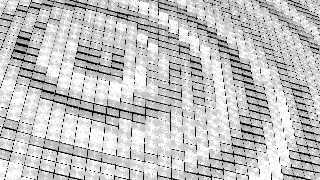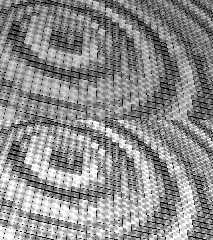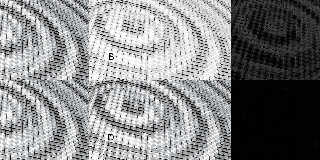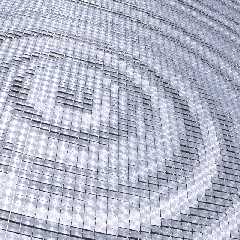 |
 |
|
 |
|
 |
|  |
|  |
|
 |
|
 |
|  |
|  |
|
 |
The best I could do is appended here. In the end, after different
experiments, I only changed the sky_sphere, replacing it by a sphere
where I could control the finish. Assumed_gamma set to 1.0 of course.
Norbert: I do not know how your sky_sphere pigment works :-/
sphere {
0, 1
pigment {
gradient <0, 1 ,0>
color_map {
blend_mode 3 blend_gamma 2.2
[0.00 rgb <1.0, 1.0, 1.0>*0.9]
[0.35 rgb <0.8, 0.8, 0.8>*0.3]
[0.65 rgb <0.8, 0.8, 0.8>*0.3]
[1.00 rgb <1.0, 1.0, 1.0>*0.9]
}
scale 2
warp {turbulence 0.5}
}
finish {emission 1 diffuse 1.0 specular 0}
scale 10e6
translate -23.0*y
}
the blend_mode and blend_gamma commands come with version 3.7.1 and
above (i.e 3.8). However, I do not see any difference by their use. I
confess that I do not really understand their explanation in the wiki.
--
Thomas
Post a reply to this message
Attachments:
Download 'nk_assumed gamma discussion.jpg' (779 KB)
Preview of image 'nk_assumed gamma discussion.jpg'

|
 |
|  |
|  |
|
 |
|
 |
|  |
|  |
|
 |
>
It's similar to a gradient y, but with only a single ramp.
function {max (min (y, 1), 0)}
The max(y,0) clamp out everything under 0.
The min(y,1) clamp out everything over 1.
Leaving you with :
-infinity..0 =0, [0..1] ramping from zero to one, than stay at one.
It is extremely bright, ranging from White*2.35 up to White*13.5.
It may be intended to simulate the glare from the Sun at the zenith.
The second does the same, but with some turbulence. Also, it's fully
transmiting. Try is with filter rather than transmit :
color_map {
[0 rgbf 1]
[0.5 rgbf <0.385,0.77,1.1,1>]
}
Things that make that render look washed out with assumed_gamma 1 :
The light is very bright at 2.42.
The sky_sphere is extremely bright.
You may want to make the sky_sphere darker, as well as the light.
Change the base colour_map :
color_map{
[0 rgb<0.06,0.1,0.5>]
[0.98 rgb<0.1, 0.3,1>]
[1 rgb 5]
}
Change the light_source to :
light_source {
<0,0,-1000>
color rgb 1.2
parallel
}
When using assumed_gamma >1, values larger than 1 get shifted toward 1,
making the scene darker. This also affect reflections and highlights,
reducing their contribution.
Alain
Post a reply to this message
|
 |
|  |
|  |
|
 |
|
 |
|  |
|  |
|
 |
Op 12/11/2019 om 17:04 schreef Alain Martel:
>>
>
> It's similar to a gradient y, but with only a single ramp.
> function {max (min (y, 1), 0)}
>
> The max(y,0) clamp out everything under 0.
> The min(y,1) clamp out everything over 1.
> Leaving you with :
> -infinity..0 =0, [0..1] ramping from zero to one, than stay at one.
> It is extremely bright, ranging from White*2.35 up to White*13.5.
> It may be intended to simulate the glare from the Sun at the zenith.
>
I assumed as much but personally I am very wary of rgb values higher
than 1, and these are really extreme. In such cases I much prefer to use
a finish {emission} setting instead.
--
Thomas
Post a reply to this message
|
 |
|  |
|  |
|
 |
|
 |
|  |
|  |
|
 |
On 11/8/19 1:45 PM, Norbert Kern wrote:
> I refer to the thread in povray.general - Future of missing "assume_gamma"
>
(http://news.povray.org/povray.general/thread/%3Cweb.5dbe6e69db426e49984b401a0%40news.povray.org%3E/).
>
...
> I tried hard to get a similar image with gamma 1, but no chance - it always
> looked boring to me.
>
> But perhaps I'm wrong - here is the source -
>
Firstly, with the scene, like the photon one back in September, it would
be useful to know how you rendered and post-processed to get the posted
image. The scenes, if rendered "normally," are extremely noisy with
respect to highlights - making, especially, any adaptive AA noisy too. I
had to use +am1 +a0.0 +r9 to get anything approaching your very clean
image. My guess is you're rendering very large images and scaling down?
Anyway, attached are two images and an updated scene file.
In AG22_mostlyGammaCorrect.jpg A and C are your 2.2 assumed_gamma scene.
B assumed_gamma (AG) to 1.0. D is a gimp gamma corrected version of B.
Trying to demonstrate that, 'mostly,' the AG 2.2 is a gamma correction
for bad linear color space textures - no matter where that correction is
done.
Due history, many textures were created around other than 1.0 gammas. If
they work for a desired result, I say use them. I do. That said, I don't
think other than assumed_gamma 1.0 the best path forward and I primarily
use AG 1.0.
In UpdateAG1v38story.jpg I'm showing at top the attached scene where
I've applied my current, usual AG 2.2 to AG 1.0 changes. The image comes
out a little dim compared to yours. On the bottom I've used gimp
(color->levels) - being lazy - to adjust the intensity of the brightest
parts to white. Normally the intensity of the lighting environment must
be increased after an AG 2.2 -> 1.0 conversion. I'd suggest something
like pow(2.42,1.5) in place of 2.42 as a start - and then dial it in
from there. Somebody did the same sort of tuning with the AG2.2 scene
set up too. Yes, normally the sky_sphere texture would be adjusted too,
but here, I don't think it's contributing much to the result.
So, easy right! Well, not always. It's still the case AG 2.2 scenes are
sometimes hard - or impossible - to map exactly to AG 1.0. It gets more
complicated with layered textures, not grey colors, color-interactions
and, of course, matching any non-physical something or other - including
AG 2.2 error - employed for effect.
Where layered textures have transparency, I find it hard to match the AG
2.2 transitions between textures. We might be able to improve this last
with modifications to the new to 3.8 blend_mode/blend_gamma features or
perhaps additional features or a utility. Not sure. Might be this less
of an issue if designing original 1.0 textures rather than converting
old stuff.
Warp, over on the developer mailing list, once mentioned we'd ideally
have implemented some utility which parses AG-not1.0 textures/scenes and
creates the initial AG 1.0 ones. Something to help people get into the
AG 1.0 space and mindset quickly. With some exceptions, I think our AG
1.0 struggles have as much to do with POV-Ray's history and practicing
momentum as anything.
Also true I'm less of a texture/material expert than many of you.
Bill P.
Post a reply to this message
Attachments:
Download 'updateag1v38story.jpg' (410 KB)
Download 'utf-8' (5 KB)
Download 'ag22_mostlygammacorrect.jpg' (327 KB)
Preview of image 'updateag1v38story.jpg'

Preview of image 'ag22_mostlygammacorrect.jpg'

|
 |
|  |
|  |
|
 |
|
 |
|  |
|  |
|
 |
> Op 12/11/2019 om 17:04 schreef Alain Martel:
>>>
>>
>> It's similar to a gradient y, but with only a single ramp.
>> function {max (min (y, 1), 0)}
>>
>> The max(y,0) clamp out everything under 0.
>> The min(y,1) clamp out everything over 1.
>> Leaving you with :
>> -infinity..0 =0, [0..1] ramping from zero to one, than stay at one.
>> It is extremely bright, ranging from White*2.35 up to White*13.5.
>> It may be intended to simulate the glare from the Sun at the zenith.
>>
>
> I assumed as much but personally I am very wary of rgb values higher
> than 1, and these are really extreme. In such cases I much prefer to use
> a finish {emission} setting instead.
>
Then again, with assumed_gamma set to 2.2, those get's compressed quite
a lot.
Post a reply to this message
|
 |
|  |
|  |
|
 |
|
 |
|  |
|  |
|
 |
> Op 12/11/2019 om 17:04 schreef Alain Martel:
>>>
>>
>> It's similar to a gradient y, but with only a single ramp.
>> function {max (min (y, 1), 0)}
>>
>> The max(y,0) clamp out everything under 0.
>> The min(y,1) clamp out everything over 1.
>> Leaving you with :
>> -infinity..0 =0, [0..1] ramping from zero to one, than stay at one.
>> It is extremely bright, ranging from White*2.35 up to White*13.5.
>> It may be intended to simulate the glare from the Sun at the zenith.
>>
>
> I assumed as much but personally I am very wary of rgb values higher
> than 1, and these are really extreme. In such cases I much prefer to use
> a finish {emission} setting instead.
>
You may try using srgb instead of rgb when declaring the colours.
Post a reply to this message
|
 |
|  |
|  |
|
 |
|
 |
|  |
|  |
|
 |
Op 14/11/2019 om 03:11 schreef Alain Martel:
>> Op 12/11/2019 om 17:04 schreef Alain Martel:
>>>>
>>>
>>> It's similar to a gradient y, but with only a single ramp.
>>> function {max (min (y, 1), 0)}
>>>
>>> The max(y,0) clamp out everything under 0.
>>> The min(y,1) clamp out everything over 1.
>>> Leaving you with :
>>> -infinity..0 =0, [0..1] ramping from zero to one, than stay at one.
>>> It is extremely bright, ranging from White*2.35 up to White*13.5.
>>> It may be intended to simulate the glare from the Sun at the zenith.
>>>
>>
>> I assumed as much but personally I am very wary of rgb values higher
>> than 1, and these are really extreme. In such cases I much prefer to
>> use a finish {emission} setting instead.
>>
>
> You may try using srgb instead of rgb when declaring the colours.
I did initially but I was not satisfied with the results at all. Then I
started messing around. I may go back to srgb again...
--
Thomas
Post a reply to this message
|
 |
|  |
|  |
|
 |
|
 |
|  |
|  |
|
 |
Here, my latest (and last for now) experiment with going from
assumed_gamma 2.2 to assumed_gamma 1.0.
I used the adapted colour_map for the sky_sphere proposed by Alain
Martel, and I changed all colours to srgb. Tweaked the light intensity
and the colour_map intensity a bit to get what I think is a clean and
correct image.
I also append a copy of my latest scene file with changes.
--
Thomas
Post a reply to this message
Attachments:
Download 'nk_assumed gamma discussion_5.png' (962 KB)
Download 'utf-8' (7 KB)
Preview of image 'nk_assumed gamma discussion_5.png'

|
 |
|  |
|  |
|
 |
|
 |
|  |
|  |
|
 |
> Here, my latest (and last for now) experiment with going from
> assumed_gamma 2.2 to assumed_gamma 1.0.
>
> I used the adapted colour_map for the sky_sphere proposed by Alain
> Martel, and I changed all colours to srgb. Tweaked the light intensity
> and the colour_map intensity a bit to get what I think is a clean and
> correct image.
>
> I also append a copy of my latest scene file with changes.
>
Definite improvement.
Post a reply to this message
|
 |
|  |
|  |
|
 |
|
 |
|  |
|  |
|
 |
Hello,
thank you all for the input.
Because of real life interferences I wasn't able to answer in due time in the
last weeks. I hope it's getting better.
Regarding William F Pokorny - I normally render my images with 8000*4500 or even
16000*9000 pixels (like in this case) and scale down via photoshop. I simply
like the details in big renders and the smooth crispy look of the scaled down
versions.
Norbert
Post a reply to this message
|
 |
|  |
|  |
|
 |
|
 |
|  |
|
 |




![]()